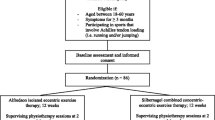Abstract
We prospectively evaluated areal bone mineral density (BMD) of the calcaneus and calf-muscle strength (concentric and eccentric plantar flexion peak torque in Nm) in 10 recreational athletes (5 males and 5 females), mean age 40.9 years (range 26–55), who were selected to undergo surgical treatment for chronic Achilles tendinosis localized at the 2–6 cm level. Surgery was followed by immobilization in a plaster cast for 2 weeks, followed by flexibility training and slowly progressing strength training and weight-bearing activity. One patient was excluded after week 0 because of a new injury. Seven patients were back to their preinjury activity at the 26-week control, and eight patients at the 52-week control postoperatively. BMD in the calcaneus and calf-muscle strength on the injured and noninjured side was measured preoperatively (week 0) and postoperatively (weeks 2, 6, 16, 26, and 52). There were no significant differences in BMD between the injured and noninjured side at weeks 0, 2, and 6, but at weeks 16, 26, and 52, BMD was significantly (P < 0.05) lower (11.5%, 18.4%, and 16.4%, respectively) in the calcaneus of the injured side. Concentric and eccentric plantar flexion strength were significantly lower on the injured side preoperatively. Eccentric, but not concentric plantar flexion strength had recovered compared with the noninjured side 1 year postoperatively. Calf-muscle strength was not related to bone mass in the calcaneus. As a comparison, we used a group of 11 recreational athletes (10 males and 1 female), with a mean age of 46.1 years (range 28.9–58.5) who had been surgically treated for chronic Achilles tendinosis at the 2–6 cm level 39.5 ± 11.8 months ago. In this group, there was no significant difference in BMD of the calcaneus between the injured and noninjured side. It seems that there was a delayed and prolonged calcaneal bone loss despite early weightbearing loading in patients surgically treated for chronic Achilles tendinosis at the 2–6 cm level. Around that time, when the Achilles tendon had healed (4–6 months) and the athletes returned to their sports, the calcaneal bone had a relatively low BMD and might possibly be vulnerable to heavy loadings. There were no signs of recovery 1 year postoperatively, but in a comparison group there were no significant side-to-side differences 39.5 months postoperatively.
Similar content being viewed by others
Author information
Authors and Affiliations
Additional information
Received: 31 December 1996 / Accepted: 21 May 1997
Rights and permissions
About this article
Cite this article
Alfredson, H., Nordström, P. & Lorentzon, R. Prolonged Progressive Calcaneal Bone Loss Despite Early Weightbearing Rehabilitation in Patients Surgically Treated for Achilles Tendinosis. Calcif Tissue Int 62, 166–171 (1998). https://doi.org/10.1007/s002239900411
Published:
Issue Date:
DOI: https://doi.org/10.1007/s002239900411



